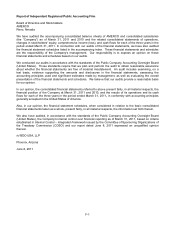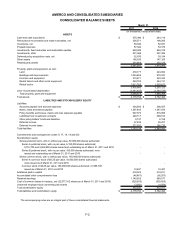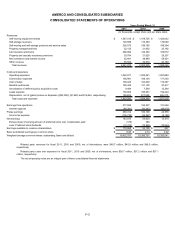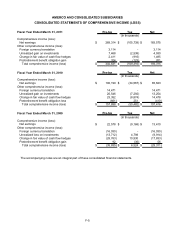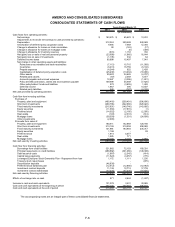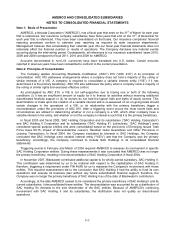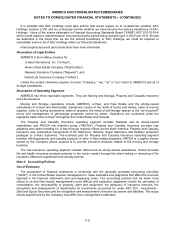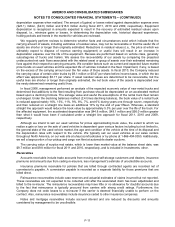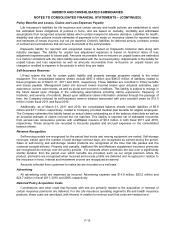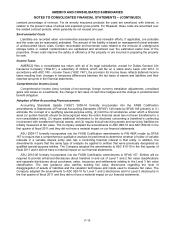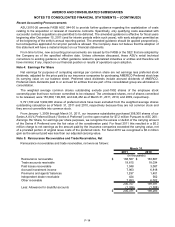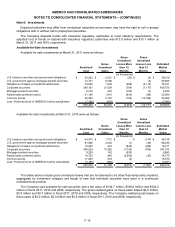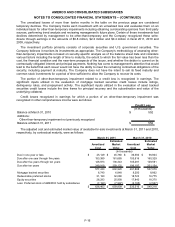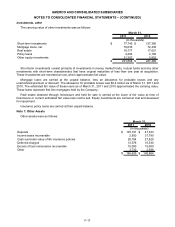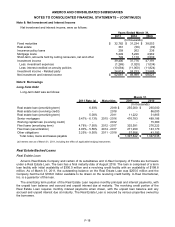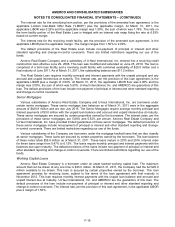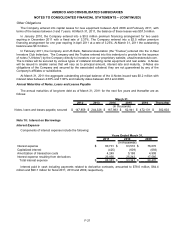U-Haul 2011 Annual Report Download - page 67
Download and view the complete annual report
Please find page 67 of the 2011 U-Haul annual report below. You can navigate through the pages in the report by either clicking on the pages listed below, or by using the keyword search tool below to find specific information within the annual report.AMERCO AND CONSOLIDATED SUBSIDIARIES
NOTES TO CONSOLIDATED FINANCIAL STATEMENTS -- (CONTINUED)
depreciation expense when realized. The amount of (gains) or losses netted against depreciation expense were
($23.1) million, ($2.0) million and $16.6 million during fiscal 2011, 2010 and 2009, respectively. Equipment
depreciation is recognized in amounts expected to result in the recovery of estimated residual values upon
disposal, i.e., minimize gains or losses. In determining the depreciation rate, historical disposal experience,
holding periods and trends in the market for vehicles are reviewed.
We regularly perform reviews to determine whether facts and circumstances exist which indicate that the
carrying amount of assets, including estimates of residual value, may not be recoverable or that the useful life of
assets are shorter or longer than originally estimated. Reductions in residual values (i.e., the price at which we
ultimately expect to dispose of revenue earning equipment) or useful lives will result in an increase in
depreciation expense over the life of the equipment. Reviews are performed based on vehicle class, generally
subcategories of trucks and trailers. We assess the recoverability of our assets by comparing the projected
undiscounted net cash flows associated with the related asset or group of assets over their estimated remaining
lives against their respective carrying amounts. We consider factors such as current and expected future market
price trends on used vehicles and the expected life of vehicles included in the fleet. Impairment, if any, is based
on the excess of the carrying amount over the fair value of those assets. In fiscal 2010, the Company reduced
the carrying value of certain older trucks by $9.1 million or $0.47 per share before income taxes, in which the tax
effect was approximately $0.17 per share. If asset residual values are determined to be recoverable, but the
useful lives are shorter or longer than originally estimated, the net book value of the assets is depreciated over
the newly determined remaining useful lives.
In fiscal 2006, management performed an analysis of the expected economic value of new rental trucks and
determined that additions to the fleet resulting from purchase should be depreciated on an accelerated method
based upon a declining formula. The salvage value and useful life assumptions of the rental truck fleet remain
unchanged. Under the declining balances method (2.4 times declining balance), the book value of a rental truck
is reduced approximately 16%, 13%, 11%, 9%, 8%, 7%, and 6% during years one through seven, respectively
and then reduced on a straight line basis an additional 10% by the end of year fifteen. Whereas, a standard
straight line approach would reduce the book value by approximately 5.3% per year over the life of the truck. For
the affected equipment, the accelerated depreciation was $44.8 million, $49.1 million and $56.0 million greater
than what it would have been if calculated under a straight line approach for fiscal 2011, 2010 and 2009,
respectively.
Although we intend to sell our used vehicles for prices approximating book value, the extent to which we
realize a gain or loss on the sale of used vehicles is dependent upon various factors including but not limited to,
the general state of the used vehicle market, the age and condition of the vehicle at the time of its disposal and
the depreciation rates with respect to the vehicle. We typically sell our used vehicles at our sales centers
throughout North America, on our web site at uhaul.com/trucksales or by phone at 1-866-404-0355. Additionally,
we sell a large portion of our pickup and cargo van fleet at automobile dealer auctions.
The carrying value of surplus real estate, which is lower than market value at the balance sheet date, was
$9.7 million and $9.8 million for fiscal 2011 and 2010, respectively, and is included in Investments, other.
Receivables
Accounts receivable include trade accounts from moving and self-storage customers and dealers, insurance
premiums and amounts due from ceding re-insurers, less management’s estimate of uncollectible accounts.
Insurance premiums receivable for policies that are billed through contracted agents are recorded net of
commission’s payable. A commission payable is recorded as a separate liability for those premiums that are
billed direct.
Reinsurance recoverables include case reserves and actuarial estimates of claims incurred but not reported.
These receivables are not expected to be collected until after the associated claim has been adjudicated and
billed to the re-insurer. The reinsurance recoverables may have little or no allowance for doubtful accounts due
to the fact that reinsurance is typically procured from carriers with strong credit ratings. Furthermore, the
Company does not cede losses to a re-insurer if the carrier is deemed financially unable to perform on the
contract. Also, reinsurance recoverables include insurance ceded to other insurance companies.
Notes and mortgage receivables include accrued interest and are reduced by discounts and amounts
considered by management to be uncollectible.
F-11


